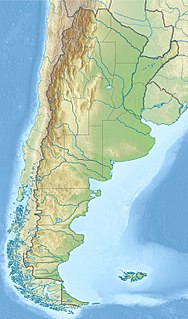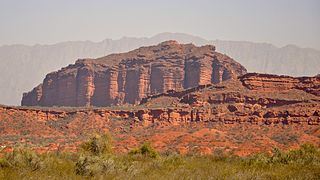
Anabisetia is a genus of iguanodont dinosaur from the Late Cretaceous Period of Patagonia, South America. It was a small bipedal herbivore, around 2 metres long.
Herbstosaurus is the name given to a genus of pterosaurs that lived during the Late Jurassic period, in what is now Argentina. In 1969 Argentine paleobotanist Rafael Herbst in the province Neuquén at Picun Leufú dug up a piece of sandstone holding a number of disarticulated bones of a small reptile. At the time it was assumed the rock dated to the Middle Jurassic (Callovian), about 163 million years ago.

The La Amarga Formation is a geologic formation with outcrops in the Argentine provinces of Río Negro, Neuquén, and Mendoza. It is the oldest Cretaceous terrestrial formation in the Neuquén Basin.

The Los Colorados Formation is a sedimentary rock formation of the Ischigualasto-Villa Unión Basin, found in the provinces of San Juan and La Rioja in Argentina. The formation dates back to the Norian age of the Late Triassic.
Cricosaurus is an extinct genus of marine crocodyliforms of the Late Jurassic. belonging to the family Metriorhynchidae. The genus was established by Johann Andreas Wagner in 1858 for three skulls from the Tithonian of Germany. The name Cricosaurus means "Ring lizard", and is derived from the Greek Cricos- ("ring") and σαῦρος -sauros ("lizard").

Caypullisaurus is an extinct genus of large platypterygiine ophthalmosaurid ichthyosaur from the Late Jurassic to the Early Cretaceous of Argentina. Its holotype was collected from the Vaca Muerta Formation of Cerro Lotena, Neuquen, dating to the early Tithonian stage of the Late Jurassic, about 150 million years ago. Caypullisaurus was first named by Marta Fernández in 1997 and the type species is Caypullisaurus bonapartei. It is a member of the family Ophthalmosauridae, and closely related to Platypterygius and Brachypterygius. In 2012, Caypullisaurus was found to be most closely related to Athabascasaurus and "Platypterygius" australis, and to nest within the subfamily Platypterygiinae.

The South American land mammal ages (SALMA) establish a geologic timescale for prehistoric South American fauna beginning 64.5 Ma during the Paleocene and continuing through to the Late Pleistocene. These periods are referred to as ages, stages, or intervals and were established using geographic place names where fossil materials where obtained.
Ilchunaia is an extinct genus of sebecid mesoeucrocodylian. Fossils have been found from the Divisadero Largo Formation of Argentina dating back to the Late Eocene, and a locality in Mendoza, Argentina dating back to the Oligocene. Little material is known from the genus, with only the anterior portion of the skull being present to study.
Notoemys is an extinct genus of platychelyid sea-turtle known from the Late Jurassic and Early Cretaceous of the Americas.

Neuquén Basin is a sedimentary basin covering most of Neuquén Province in Argentina. The basin originated in the Jurassic and developed through alternating continental and marine conditions well into the Tertiary. The basin bounds to the west with the Andean Volcanic Belt, to the southeast with the North Patagonian Massif and to the northeast with the San Rafael Block and to the east with the Sierra Pintada System. The basin covers an area of approximately 120,000 square kilometres (46,000 sq mi). One age of the SALMA classification, the Colloncuran, is defined in the basin, based on the Collón Curá Formation, named after the Collón Curá River, a tributary of the Limay River.

Eurysternum is an extinct genus of sea turtle. Its type species is Eurysternum wagleri, the holotype of which has since been lost and only survives in illustrations.

The Vaca Muerta Formation, commonly known as Vaca Muerta is a geologic formation of Late Jurassic to Early Cretaceous age, located in the Neuquén Basin in northern Patagonia, Argentina. It is well known as the host rock for major deposits of shale oil and shale gas.

President Cristina Fernández de Kirchner of Argentina introduced a bill on April 16, 2012 for the partial renationalization of YPF, the nation's largest energy firm. The state would purchase a 51% share, with the national government controlling 51% of this package and ten provincial governments receiving the remaining 49%. The bill was overwhelmingly approved by both houses of Congress, and was signed by the president on May 5.
Yaminuechelys is an extinct genus of chelid turtle from Argentina and the Dorotea Formation of Chile. The genus first appeared during the Late Cretaceous, and then becomes extinct during the Late Paleocene.

The Bajada Colorada Formation is a geologic formation of the southern Neuquén Province in the Neuquén Basin of northern Patagonia, Argentina. The formation belongs to the Mendoza Group and is Late Berriasian to Early Valanginian in age. The formation is renowned for preserving fossil remains of Bajadasaurus pronuspinax, a genus of dicraeosaurid dinosaurs named after the formation.

The Agrio Formation is an Early Cretaceous geologic formation that is up to 1,500 metres (4,900 ft) thick and is located in the southern Mendoza Province and northern-central Neuquén Province, in the Neuquén Basin of northwestern Patagonia, Argentina. This formation is the youngest one of the Mendoza Group, overlying the Mulichinco and Bajada Colorada Formations and overlain by the Huitrín and La Amarga Formations. It is dated to the Late Valanginian to Early Hauterivian, Late Valanginian to Early Barremian, or Hauterivian to earliest Aptian.

The Gaiman Formation, in older literature also referred to as Patagonian Marine Formation, is a fossiliferous geologic formation of the Peninsula Valdés Basin in the eastern Chubut Province of northwestern Patagonia, eastern Argentina.
Simpsonotus is an extinct genus of notoungulate mammals in the family Henricosborniidae from the Middle to Late Paleocene of South America. Fossils of the genus have been found in the Mealla Formation, a fluvial and lacustrine sedimentary unit of the Salta Basin in northwestern Argentina. The genus name honors paleontologist George Gaylord Simpson.

The Río Loro Formation is a geological formation of the Sierras Pampeanas in Tucumán Province Argentina whose strata date back to the Late Paleocene of the Paleogene, or Riochican in the SALMA classification.
Prochelidella buitreraensis was a species of fossil turtle assigned to the family Chelidae, a group of freshwater turtles which lived in the Cenomanian during the Upper Cretaceous, approximately 100 million years ago. Its specific epithet, buitreraensis, is due to the paleonthologic site La Buitrera, where it was found.








